Accepted Scientific Name: Livistona chinensis (Jacq.) R.Br. ex Mart.
Hist. Nat. Palm. 3: 240 (1838) Mart.
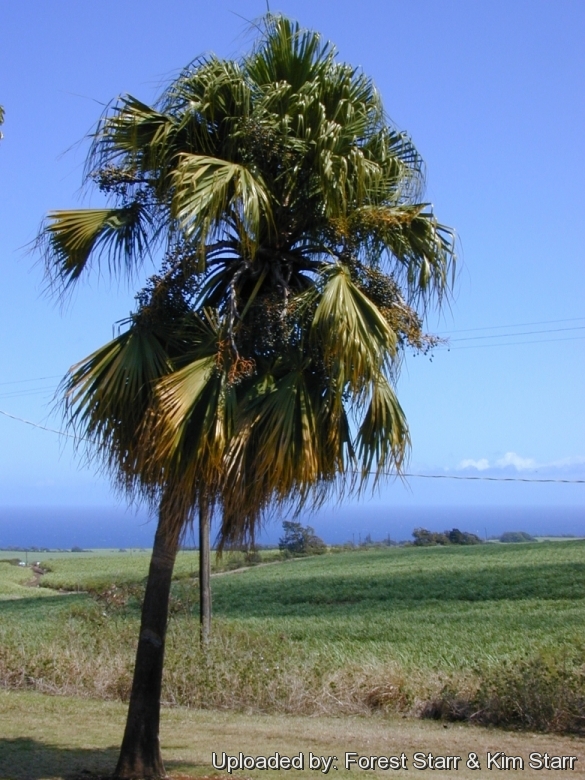
Saribus chinensis (Livistona chinensis) Photo by: Forest Starr & Kim Starr
Habit at Paia, Maui, Hawaii (USA). March 30, 2001.
Origin and Habitat: Southern Japan, central China, Taiwan and several islands in the South China Sea.
Habitat: Coastal forests, often on sandy soil at low elevations.
Ecology: This species is pollinated by wind and a variety of insects and animals such as beetles, bees, flies, ants, and bats. The seeds of Livistona chinensisSN|24528]]SN|24528]] spread by gravity. It may be possible that plants also spread in water and, nowadays, primarily by humans using the plants in landscaping. This plant can become a weed, or in some ecosystems an invasive species - such as in Florida wetlands and on some Caribbean Islands.
Synonyms:
See all synonyms of Livistona chinensis
back
Accepted name in llifle Database:Livistona chinensis (Jacq.) R.Br. ex Mart.Hist. Nat. Palm. 3: 240 (1838)Synonymy: 14
back
Common Names include:
ENGLISH: Fountain palm, Serdang palm, Chinese fountain palm, Chinese fan palm
ARABIC ( لعربية ): نخيل ليفستونيا الصيني
CANTONESE (粵語): 蒲葵, 蒲葵樹
CHINESE (中文): 扇叶葵, 蒲葵, Shan ye kui, Pu kui
CROATIAN (Hrvatski): Kineska livistona
DUTCH (Nederlands): Chinese schermpalm
FRENCH (Français): Palmier évantail de Chine, Palmier fontaine
GERMAN (Deutsch): Chinesische Fächerpalme, Chinesische Schirmpalme
HUNGARIAN (Magyar): Kínai legyezőpálma
ITALIAN (Italiano): Palma fontana, Ventaglio cinese
JAPANESE (日本語): Birou, Kuba
MALAY (بهاس ملاي /Bahasa Melayu ): Serdang Cina
NORWEGIAN (Bokmål): Kinesisk viftepalme
POLISH ( Polski): Liwistona chińska
SPANISH (Español): Palmera de abanico china, Livistona de China
THAI (ภาษาไทย): Paam jeep, Paam jin
VIETNAMESE (Tiếng Việt): Cọ xẻ
Description: Livistona chinensisSN|24528]]SN|24528]] is a versatile and inexpensive hardy species widely used as ornamental in tropical and temperate areas. The divided leaves have long, tapering, ribbon-like segments which gracefully sway beneath the leaves, creating an overall fountain-like effect. Although usually seen as a low growing, shrubby tree, it can grow quite tall.
Trunk: Solitary, straight, brown with non-persistent leaf base, usually about 4,5-9 m tall in cultivation, but up to to 15 m or more tall in its native habitat, up to 30(-45) cm in diameter and wider at the base.
Crown: It forms a dense canopy with numerous fronds, spread 3-3.7 m. No crownshaft.
Leaves: Coatapalmate, p to 1,8 m in diameter, pale to bright green, fan-shaped, divided to approximately half way into about 75-90 ribonlike segments that droop downward to give a gracefully fountain-like appearance. Only a slight breeze is needed to move leaf segments adding a fine textured effect. Segment tips deeply bifid. Margin entire. Petioles armed with stout prickles.
Inflorescences: 1-1,8 m long with several branches on a single main rachis,
each 2-3 times divided into rachillae, bracts brown tomentose. hidden within the crown. Flowers inconspicuous, pale yellow-white.
Blooming season: Spring-summer.
Fruit: Oval, round or pyriform, about 1,5-2,6 cm long, 0,9-1,8. There is a single seed inside each fruit.
cm in diameter.2 cm wide, bright green that turn dark blue to blue-grey when ripe that hang in dense clusters.
2n: 36
Remarks: A dwarf variety (Livistona chinensisSN|24528]]SN|24528]] var. subglobosa) is available and particularly used as an indoor plant.
Bibliography: Major references and further lectures
1) Forest & Kim Starr Livistona chinensis (Chinese fan palm). Plants of Hawaii. <http://www.starrenvironmental.com>. Downloaded on 21 August 2014.
2) John Dransfield, Natalie W. Uhl “Genera Palmarum: the evolution and classification of palms” Kew Pub., 2008
3) Andrew Henderson “Palms of Southern Asia” Princeton University Press, Princeton and Oxford 27/Apr/2009
4) Don Ellison, Anthony Ellison “Cultivated Palms Of The World” UNSW Press, 01/May/2001
5) Barfod, A.S. & Dransfield, J. (2013). “Flora of Thailand” 11(3): 323-498. The Forest Herbarium, National Park, Wildlife and Plant Conservation Department, Bangkok.
6) Wikipedia contributors. "Livistona chinensis" Wikipedia, The Free Encyclopedia. Wikipedia, The Free Encyclopedia, Accessed on 28 Aug. 2014
7) Palmpedia contributors. "Livistona chinensis." Palmpedia, PALM ENCYCLOPEDIA, <http://www.palmpedia.net> Downloaded on 26 Aug. 2014
8) Robert Lee Riffle, Paul Craft “An Encyclopedia of Cultivated Palms” Timber Press, Portland 2007
9) "Livistona chinensis." PACSOA Palms and Cycads wiki , <http://www.pacsoa.org.au> Accessed on 28 Aug. 2014
10) Pooma, R. (ed.). “A preliminary check-list of threatened plants in Thailand” National Park, Wildlife and Plant Conservation Department, Bangkok. 2005
11) Govaerts, R. & Dransfield, J. “World Checklist of Palms”. The Board of Trustees of the Royal Botanic Gardens, Kew. 2005.
12) Dowe, J.L., “A taxonomic account of Livistona R.Br. (Arecaceae).”
13) Oxford University Press "Flora of North America" volume 22, 2000
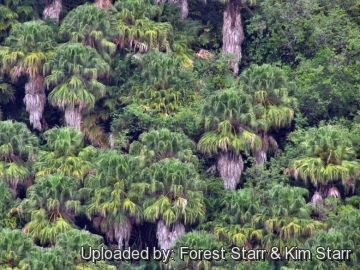 Habit on steep gulch wall at Hamakua Coast, Hawaii (USA). July 18, 2012. (Livistona chinensis) Photo by: Forest Starr & Kim Starr
Habit on steep gulch wall at Hamakua Coast, Hawaii (USA). July 18, 2012. (Livistona chinensis) Photo by: Forest Starr & Kim Starr Habit at Kahanu Gardens NTBG Kaeleku Hana, Maui, Hawaii (USA). November 04, 2009. (Livistona chinensis) Photo by: Forest Starr & Kim Starr
Habit at Kahanu Gardens NTBG Kaeleku Hana, Maui, Hawaii (USA). November 04, 2009. (Livistona chinensis) Photo by: Forest Starr & Kim Starr Fruit at Kahanu Gardens NTBG Kaeleku Hana, Maui, Hawaii (USA). November 04, 2009. (Livistona chinensis) Photo by: Forest Starr & Kim Starr
Fruit at Kahanu Gardens NTBG Kaeleku Hana, Maui, Hawaii (USA). November 04, 2009. (Livistona chinensis) Photo by: Forest Starr & Kim Starr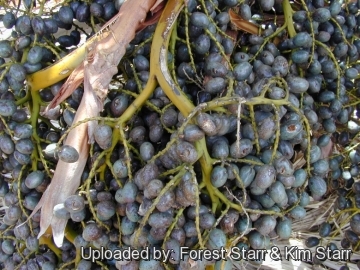 Fruits at plantation Waikapu, Maui, Hawaii (USA). April 20, 2001. (Livistona chinensis) Photo by: Forest Starr & Kim Starr
Fruits at plantation Waikapu, Maui, Hawaii (USA). April 20, 2001. (Livistona chinensis) Photo by: Forest Starr & Kim Starr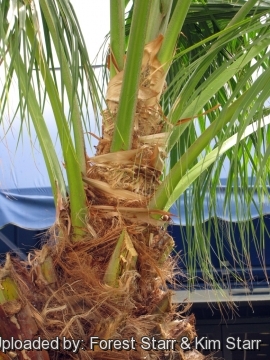 Trunk and frond stems at Holiday Inn Express Boynton Beach, Florida, Hawaii (USA). September 23, 2009. (Livistona chinensis) Photo by: Forest Starr & Kim Starr
Trunk and frond stems at Holiday Inn Express Boynton Beach, Florida, Hawaii (USA). September 23, 2009. (Livistona chinensis) Photo by: Forest Starr & Kim Starr Leaves at Huelo, Maui, Hawaii (USA). March 06, 2007. (Livistona chinensis) Photo by: Forest Starr & Kim Starr
Leaves at Huelo, Maui, Hawaii (USA). March 06, 2007. (Livistona chinensis) Photo by: Forest Starr & Kim Starr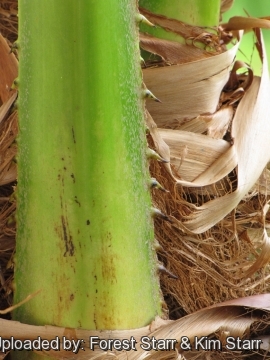 Armed stems at Holiday Inn Express Boynton Beach, Florida. September 23, 2009. (Livistona chinensis) Photo by: Forest Starr & Kim Starr
Armed stems at Holiday Inn Express Boynton Beach, Florida. September 23, 2009. (Livistona chinensis) Photo by: Forest Starr & Kim StarrSend a photo of this plant.The gallery now contains thousands of pictures, however it is possible to do even more. We are, of course, seeking photos of species not yet shown in the gallery but not only that, we are also looking for better pictures than those already present.
Read More... Cultivation and Propagation: It is cultivated in tropical, subtropical and temperate regions and planted in gardens and parks. If you needs a low maintenance, but graceful looking palm, it doesn't get any better than Livistona chinensisSN|24528]]SN|24528]]. It's usually seen in clumps and tolerating neglects.
Soil: It is suited for fertile, loamy substrates, but it is adaptable to many kinds of well-drained soils, including clay; sand; alkaline or acidic.
Fertilization: Need a perfect fertilizer diet including all micro nutrients and trace elements or slow release fertilizer applied during the growing season, or according to package directions, using a fertilizer specifically formulated for palms.
Water Requirements: It tolerates low levels of humidity, though it prefers evenly moist but not consistently wet medium. Plants should be watered during dry spells and will benefit from an organic mulch. When supplied with adequate moisture and fertilizer it is also fairly fast growing. This palm forms a long tap root and can survive extended periods of drought once established. It dislikes soggy soils.
Light: It prefers bright sunny locations, but it also does well in part shade with some direct sunlight, young specimens should be partially shaded. It will also survive in rather heavy shade but "stretches" to lose its compact shape. It produces flowers and fruit only in sunny positions.
Aerosol salt tolerance: Scarce.
Wind resistance: It is fairly resistant to breakage but avoid strong wind.
Hardiness: It is a hardy species surviving in tropical and temperate climates, though growth may be slower in temperate areas. ( ZONES: (9A),9B, 10A, 10B, 11, This palm may also be hardier Zone 8 and survives routinely winter temperature down to -10° C with no ill effect, but it may survive temperatures as low as -15° C degrees which burns the leaves but the plant recovers readily.
Roots: Usually not a problem.
Maintenance: The palm is self-cleaning of old leaves and will require little or no pruning.
Pest and diseases: It is fairly vulnerable to lethal yellowing disease.
Uses: It is used massively in gardening and landscaping in many parts of the world though in sheltered areas it will survive periods below freezing point. Its neat form makes it ideal for staggered groupings, street without pavement, parking lot island, sidewalk cutout (tree pit), highway median, tree lawn or used as a free-standing specimen. They form a closed canopy when planted about 3 m apart along a walk or street. They grow well in confined soil spaces and can thrive in harsh urban conditions. It is also excellent in containers and urns. It also tolerates shady spots and it is a good indoor container plant often seen inshopping malls, especially when young.
Propagation: Fresh seeds if kept warm germinate readily within 1 to 4 months of sowing.
















